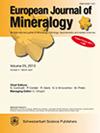Nomenclature of the triphylite group of minerals
IF 1.7
3区 地球科学
Q2 MINERALOGY
引用次数: 0
Abstract
Abstract. In this paper we present a Commission on New Minerals, Nomenclature and Classification of the International Mineralogical Association (IMA-CNMNC)-accepted scheme for the classification and nomenclature of the triphylite group of minerals. The general formula of those minerals is M1M2TO4, where M1 and M2 refer to cations in an octahedral coordination: M1 = □, Na, Li; M2 = Mn2+, Fe2+, Mg, Fe3+, Mn3+, and T to tetrahedrally coordinated P5+ cations. The group contains the Li-bearing phosphates triphylite [LiFe2+(PO4)] and lithiophilite [LiMn2+(PO4)] and their oxidation products heterosite [Fe3+(PO4)] and purpurite [Mn3+(PO4)], as well as the Na-bearing phosphates natrophilite [NaMn2+(PO4)] and karenwebberite [NaFe2+(PO4)]. The Li–Mg-bearing phosphate simferite has been redefined as LiMg(PO4). Ferrisicklerite and sicklerite correspond to intermediate phases in the triphylite–heterosite and lithiophilite–purpurite solid solutions; consequently, according to the CNMNC dominant-constituent rule, they are discredited. A new mineral oxidation sequence is defined, which considers the different oxidation capacity of iron and manganese, and therefore replaces the traditional Quensel–Mason sequence. The formula calculation procedure for Li-bearing species, based on electron microprobe analyses and single-crystal X-ray diffraction data, is also described.矿物中三叶绿石群的命名法
摘要在本文中,我们提出了国际矿物学协会(IMA-CNMNC)接受的新矿物、命名和分类委员会(Commission on New Minerals, naming and Classification)对三叶石矿物群的分类和命名方案。这些矿物的通式为M1M2TO4,其中M1和M2是指在八面体配位中的位置:M1 =□,Na, Li;M2 = Mn2+,Fe2+, Mg, Fe3+, Mn3+,和T到四面体配位p5 +阳离子。该基团含有含锂磷酸盐三叶石[LiFe2+(PO4)]、亲锂矿[LiMn2+(PO4)]及其氧化产物异质矿[Fe3+(PO4)]、紫砂矿[Mn3+(PO4)],以及含钠磷酸盐亲钠矿[NaMn2+(PO4)]、卡伦钠矿[NaFe2+(PO4)]。含铁镁磷铁铁矿重新定义为LiMg(PO4)。铁绢石和镰绢石对应于三绿石-异质石和嗜石-紫石固溶体的中间相,因此,根据CNMNC优势成分规则,它们是不可信的。考虑到铁和锰的不同氧化能力,定义了一种新的矿物氧化序列,从而取代了传统的Quensel-Mason序列。本文还描述了基于电子探针分析和单晶x射线衍射数据的含锂物质的公式计算过程。
本文章由计算机程序翻译,如有差异,请以英文原文为准。
求助全文
约1分钟内获得全文
求助全文
来源期刊
CiteScore
2.80
自引率
9.50%
发文量
40
审稿时长
6-12 weeks
期刊介绍:
EJM was founded to reach a large audience on an international scale and also for achieving closer cooperation of European countries in the publication of scientific results. The founding societies have set themselves the task of publishing a journal of the highest standard open to all scientists performing mineralogical research in the widest sense of the term, all over the world. Contributions will therefore be published primarily in English.
EJM publishes original papers, review articles and letters dealing with the mineralogical sciences s.l., primarily mineralogy, petrology, geochemistry, crystallography and ore deposits, but also biomineralogy, environmental, applied and technical mineralogy. Nevertheless, papers in any related field, including cultural heritage, will be considered.

 求助内容:
求助内容: 应助结果提醒方式:
应助结果提醒方式:


